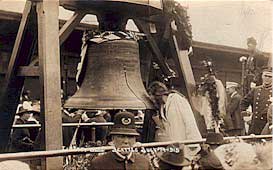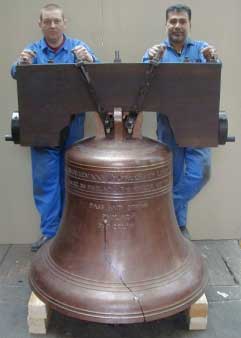|
The Liberty Bell
Inscription.
The source of the inscription is Leviticus 25:10, which reads
The inscription was intended to mark the 50th anniversary of William Penn's Charter of Privileges of 1701. ** Note that the spelling of "Pennsylvania" was not at that time universally adopted. In fact, in the original Constitution, the name of the state is also spelled "Pensylvania."
How did the Liberty Bell come into being? Casting the Bell. After the bell was hung, it was reported that it cracked on the first stroke, it was intended to return it to England, but the ship's Captain could not take it on board. Two Philadelphia workmen, Pass and Stow, undertook to recast it, when breaking up Lester's work they believed it too brittle, and then modified the alloy by adding 1.5 ounces of copper for every pound weight of Lester's bell. They were unaware that bell metal needs to be brittle, to allow a freedom of tone when struck. The second casting was also unsuccessful, so for the third time it was recast, this time with the right balance of metal. In 1753, further dissatisfaction with the bell was expressed, and Thomas Lester agreed to to again recast the bell for 2 pence per pound weight of it, but that did not happen. So, Pass and Stow's second casting was finally hung in the State House Steeple. Fear of the British. How did the bell become cracked? Another story which gives more detail appeared in the Reading Eagle in 1911 and was told to the reporter by Emmanuel Joseph Rauch who was then about 86 years of age. He told how, when he was 10 years old in 1835, he was one day passing State House Square when the Steeple Keeper - whose name was Downing - called after him and several other boys, inviting them to ring the bell in honour of Washington's birthday. Downing tied a rope to the clapper of the bell and, thrusting the end of the rope into the hands of the eager boys, instructed them to pull with all their might. After 10 or 12 strokes, there was a change in the tone of the bell which Downing noticed as well and, after climbing into the steeple, found a crack 12" to 15" long, whereupon the boys were told to run along home. Which of these two stories is true we may never know, but the fact remains that the principal crack is in line with the swing of the clapper and it is an established fact that many bells have been cracked by the improper operation of the clapper in this way. Size of Crack: Bell Statistics:
Have Bell - will travel. Among the more obscure events in American history involves the Liberty Bell's travels by rail car around the United States to be placed on exhibit at numerous World's Fairs. From 1885 to 1915, the Liberty Bell traveled by rail on seven separate trips to eight different World's Fair exhibitions visiting nearly 400 cities and towns on those trips coast to coast. At the time, the Liberty Bell's trips were widely publicized so that each town where the Liberty Bell train stopped was well prepared for their venerable guest. Each stop on the way to the host World's Fair exhibition lasted anywhere from a few minutes to a couple of hours. The Liberty Bell was nearly always met with military salutes, parades, patriotic music and throngs of cheering men, women and children. The Liberty Bell Journeys. 1893 - Philadelphia to Chicago for the World's Columbian Exposition 1895-96 - Philadelphia to Atlanta for the Cotton States and International Exposition 1902 - Philadelphia to Charleston, S.C., for the Inter-State and West Indian Exposition 1903 - Philadelphia to Boston for the 128th Anniversary of the Battle of Bunker Hill 1904 - Philadelphia to St. Louis for the Louisiana Purchase Exposition (the St. Louis World's Fair) 1915 - Philadelphia to San Francisco for the Panama-Pacific Exposition and to San Diego for the Panama California Exposition 250th. Anniversary of the Liberty Bell. 2001 marked the 250th. anniversary of the casting of the now famous Liberty Bell, and Whitechapel Foundry was commissioned to cast a replica of the this US artifact.
Another Liberty Bell.
Biecenntenial Bell. Liberty Bell moves. On April 6, 2001, the Liberty Bell was struck several times with a hammer by Mitchell Guilliatt, a self-described wanderer from Nebraska. He hit the bell four times while shouting "God lives!" The reason he gave was to declare his independence from the United States of America and not to attempt to deface or destroy the bell. After repairs, there was no visible damage to the bell (other than the famous crack). In October 2003, the bell was moved a short distance southwest to a new pavilion, the Liberty Bell Center. There was some controversy about the site chosen for the new structure, which was just to the south of the site of where George Washington had lived in the 1790s. After the initial planning, the building's site was found to be adjacent to the quarters for the slaves owned by Washington. The decision over how to acknowledge this fact in the display has led to some debate. In 2007, the bell remains in this location at the northeast corner of 6th and Chestnut Streets. The new National Constitution Center is located two blocks to the north, and Independence Hall is located directly across the street, on the south side of Chestnut Street between 5th and 6th Streets.
Conclusion. |




